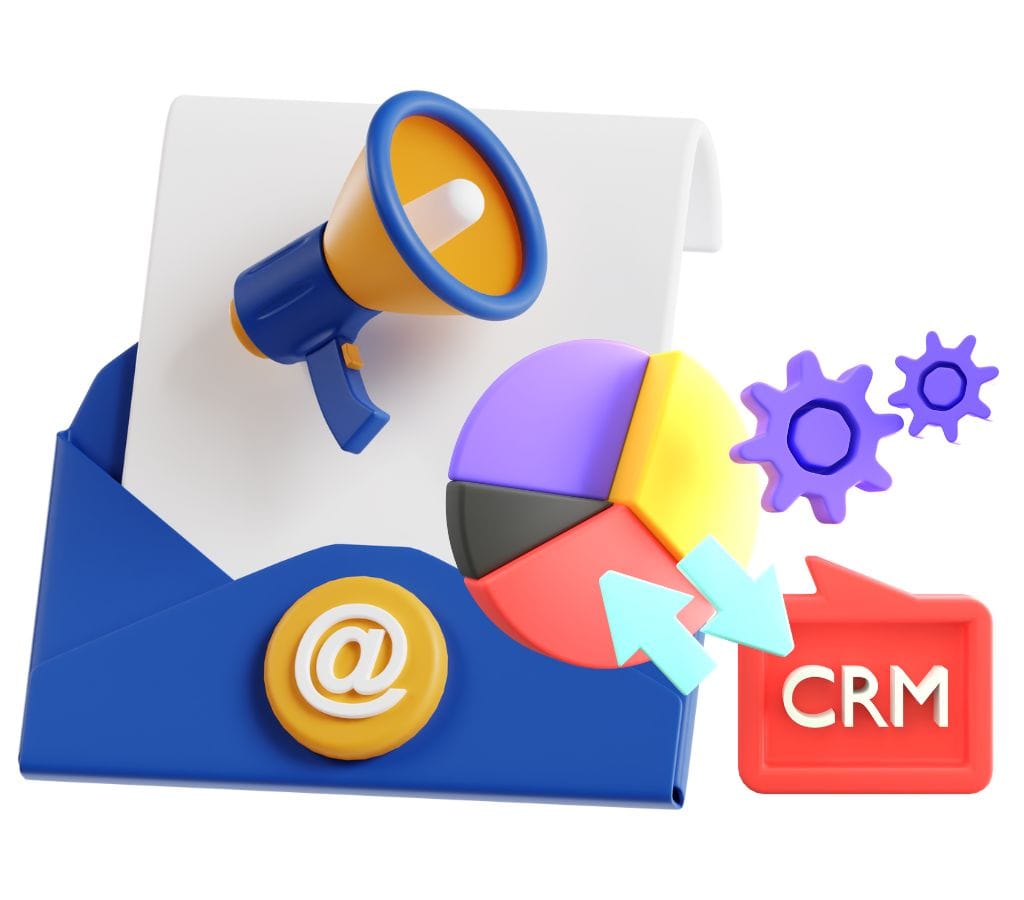Building and maintaining customer relationships is very important for email marketing success. CRM (Customer Relationship Management) in email marketing is very important to this process because it is a great way to connect with customers and gain their trust. Your email marketing campaign will be more successful if you know how to write good email marketing. This blog post will detail CRM in email marketing, such as why they're important, what they look like, and how to write content that hits home with your customers.
What is Email Marketing?
Email marketing is a strong digital marketing tool for sending commercial emails to customers. This is a quick and easy approach to contacting current or potential customers interested in your business or products. This marketing strategy also helps organizations connect with their audience, establish relationships, sell products, engage customers, and achieve marketing goals.
Email marketing has become a popular and effective selling method because it has so many benefits. It's a cheap way to get your message to many people. Especially when compared to old-fashioned marketing methods such as direct mail or print ads. Also, email marketing lets you send personalized and targeted messages, so companies can make their content fit the needs of different groups of people based on their demographics, interests, or behaviors.
Email marketing also gives you a way to measure and track how well your campaigns are doing. Businesses can learn a lot about email marketing performance by measuring key metrics such as open, click-through, and conversion rates. They can then use this information to make the best choices for their business.
Overall, email marketing is a flexible and effective tool for businesses to communicate with their audience, promote their brand, and persuade people to buy. In order to fully understand the importance of email marketing in this larger marketing strategy, you need to know the basics of email marketing.

Why CRM in Email Marketing is Important?
CRM is very important in email marketing because it helps the effort do well as a whole. So here are reasons why these kinds of emails are important:
- Building Trust: A good way to get customers to trust and believe in you is to send them friendly emails. If you always post important and useful things for your customers, they will see you as an expert in your area and trust you.
- Strengthening Customer Loyalty: CRM email marketing is a great way to keep people interested in your business for a long time. You can also get customers to buy from you again and tell others about your brand if you repeatedly meet their wants and give them value.
- Driving Engagement: Email marketing is a great way to get people to connect with your products. When you send emails, ensure the information is interesting and useful to the people reading it. They'll be more interested in your brand after this.

Characteristics of CRM Email Marketing
CRM email marketing differs from other types of emails in a few ways. The following are some of these traits:
- Personalization: Emails in a relationship are very personalized because they use the other person's name and include details about their likes or dislikes. It makes people feel like they are getting more care and helps people connect with each other better.
- Value-Driven Content: Email marketing aims to give the other person something of value. Usually, they give subscribers fun, useful, or educational content that fits their interests or needs. You can keep people interested in your business and involved by giving them useful information.
- Consistency: CRM emails are sent daily, which lets everyone talk to each other. Soon, people will look forward to and get used to getting your emails. This will help you gain their trust.
Difference Between CRM Emails and Transactional Emails
Emails that are sent after a particular action or event, such as confirming a purchase, resetting a password, or letting you know that something has been shipped, are called transactional emails. Transactional emails are mostly about getting information across and closing a deal. However, email marketing is about getting to know your audience and building a relationship with them.
In order to make an effective email marketing campaign that focuses on building relationships and engaging with your audience, you need to understand what email marketing is. So, we'll talk about writing compelling emails that your customers will like in the next part.

How to Write CRM Email Marketing
Writing good CRM email marketing is an important part of making an email marketing campaign. These emails are meant to excite people, help you earn their trust, and strengthen your relationships with them. So, here are some important steps that will help you write great CRM email marketing:
Understand Your Customer
- Audience Segmentation: Firstly, split your email list into groups based on age, gender, interests, buying habits, or engagement. By changing them, you can ensure the emails are right for each group.
- Customer Persona: Make fleshed-out customer profiles to learn more about your target group. Also, think about their issues, what drives them, what they like, and how they want to be contacted.
Tips for Writing CRM Emails
- Clear and Compelling Subject Line: Write subject lines that make people want to open your emails. Make them want to read it right away or be interested in a brief email and emphasize the benefits.
- Engaging and Relevant Content: Write content your customer finds interesting, useful, and connected. Take care of their issues, offer answers, talk about what you know about the business, or offer special deals. Make it easy to read and understand, as well as interesting.
- Call-to-Action (CTA): Make sure it is clear and interesting so that people want to do what you want them to do. You can ask people to go to your website, buy something, sign up for an event, or share the email. Because it makes the CTA stand out and makes the benefits clear.
- Visual Appeal: Add pictures, videos, graphs, or GIFs that are easy on the eyes to your emails to make them look better. Visuals can catch people's attention, help them understand things better, and help them remember what they saw.
How to Personalized Email Marketing
- Personalized Salutations: Address recipients by their name in the email greeting. People feel like they are getting special attention and a connection with this easy way.
- Dynamic Content: Dynamic content lets you customize email content based on signups. For example, personalized product ideas, limited-time discounts, or messages based on how you've interacted with the business in the past.
- Behavioral Triggers: Use behavioral triggers to send emails based on certain actions or events. For example, thank a customer for five years of loyalty or follow up with someone who left their shopping cart but didn't check out with a personalized email.

Analyzing the Impact of CRM on Email Marketing
To see how well your email marketing is doing and make decisions about how to improve your campaign, you need to look at how your emails are doing. You can learn a lot about how well your emails work by measuring key things and figuring out what the data means. In order to figure out how email marketing affects your customers, follow these steps:
Key Metrics to Measure Success
- Open Rate: This number tells you how many people view your link emails. It means that your subject lines and how you come across as a writer are good at getting people to open and read your emails.
- CTR (Click-Through Rate): This number tells you how many people open your emails and click on the links inside them. People will want to do something if your CTR is high. This means that your content and call to action are interesting and effective.
- Conversion Rate: That number tells you how many people who get your email do what you want them to do, such as buy something, sign up for a meeting, or fill out a form. You can tell how well your emails work by monitoring the return rate.
- Unsubscribe Rate: This number tells you how many people choose not to get emails from your brand anymore. If you keep an eye on this rate, you can find issues with your emails, like ones that aren't necessary or that come too often.
Analyzing and Interpreting Data
- A/B Testing: You can use A/B tests to find out which parts of your emails work better, such as the subject lines, the texts, the pictures, or the calls to action (CTAs). You can find the best ways to get people interested by trying different things and seeing what works.
- Segmentation Analysis: Test your emails with different groups of people to see how well they work. You can compare things such as open rates, click-through rates (CTRs), and sales to see which groups respond well to your emails and which ones might need changes.
- Engagement Patterns: Look at engagement patterns over time to see any patterns or trends in how people act. Are there specific days or times when your emails perform better? This information can help you choose the best time to send your emails so they get the most attention.
- ROI Analysis: Assess the return on investment (ROI) of your email campaigns. Find out how much money you made from sales that emails led to and compare that to how much email marketing costs. This study tells you how well and how much money your email campaigns make.
Adjusting Your Strategy Based on Results
If you look at how your emails touch people, you can figure out how to improve your plan. Look at these things that were done:
- Content Optimization: Improve the text of your emails by making small changes based on what works best for your readers. Find the most useful parts of the text in the data and use them again and again.
- Segment Refinement: Sort your viewers into smaller groups based on their engagement and what they like. Moreover, make sure that your emails meet the wants of each group.
- Testing and Experimentation: Try out new things and constantly test different parts of your emails to find better ways to write them. You can test different things on your list, such as subject lines, calls to action, pictures, and ways to make them feel more like you.
To improve your email marketing plan and get more engagement, sales, and total campaign success, you should keep track of and make changes to the results of your email campaign regularly. In the next part, we'll look at some real-life email marketing campaigns that worked well to give you ideas for your own.

Case Studies of Successful Email Marketing Campaign
Let's look at some real-life examples of great email marketing campaigns to get ideas and tips for your own. These case studies show strategies that have worked well and led to amazing results:
Case Study 1: The Wanderlust Travel Co.
With their focus on high-end vacations, The Wanderlust Travel Co. wanted to improve their relationships with their subscribers and get more reservations.
Strategy
- Highly Customized Ideas: Wanderlust Travel Co. sent subscribers highly customized travel ideas based on their hobbies and past trips, using data from the subscribers they chose and the trips they had booked in the past.
- Exclusive Offers: As a subscriber, you can get free upgrades, early access to limited offers, and other perks.
- Engaging Content: The Wanderlust Travel Co. sent their readers useful and interesting content such as travel guides, customer testimonials, and guides to different places to visit.
Results
- Since the last campaign, the open rate went up by 25%.
- The number of people who clicked through to their website went up by 18%.
- A lot more people booked—30% more than before.
Case Study 2: FitFam Fitness Studio
A CRM email marketing for a local fitness center, FitFam Fitness Studio, was meant to keep members longer and get them more active with the gym.
Strategy
- Personalized Workout Plans: FitFam Fitness Studio sent each member a workout plan made just for them based on their fitness goals, tastes, and past progress. This included individual workout plans, tips on how to eat well, and motivational content.
- Event Invitations: Members were invited to special fitness events, workshops, and challenges to get them involved with the FitFam group.
- Member Spotlights: Under the title "member spotlights," FitFam Fitness Studio talked about the changes and successes of its members. These stories brought people together and made them feel like they were part of a group.
Results
- There were more than 20% more members kept than the year before.
- 15% more members participated in exercise tasks and events, which shows they were more interested.
- Their present members helped them get 25% more new members by giving them ideas.
Case Study 3: PetLab Inc.
PetLab Co. is a business that makes great food and care items for dogs. The company sells many different items and has a customer base with both new and returning customers. They had to make sure their email marketing worked and reached the right people.
Strategy
That's why the company changed their ads to make every pet owner feel like they were the best of the bunch. They did many A/B tests to see what changes would be made to the number of opens if the CTAs, the time of the sends, or even taking PetLab Co.'s name out of the subject lines were changed.
Results
- When we compared our best-performing campaign to PetLab Co.'s campaign before CodeCrew, the click rate went up by 53.33%.
- A 24.29 percent rise in the number of opens from our best campaign to PetLab Co.'s best campaign before CodeCrew.
- An average rise of 4.34% in click rates.
- A drop of 33.33% in bounce rates.
With these case studies, you can see how effective email marketing can be in different areas. By personalizing content, giving away special benefits, and making people feel like they are part of a community, businesses can get their audience more involved, build better relationships with them, and meet their marketing goals.

